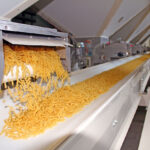Effective food safety risk assessments are crucial for protecting public health, safeguarding brand reputation and ensuring the integrity of the food supply chain. The importance of this process is underscored by regulations such as the Food Safety Modernization Act (FSMA), which mandates the identification of biological, chemical, and physical hazards in food production and distribution (1).
Our video clip below reviews key aspects to conduct thorough food safety risk assessments, featuring FoodChain ID’s Karen Everstine, MPH, PhD, Technical Services Director, Food Safety Solutions.
Want to learn more? Click here to view the full webinar.
Evaluating and prioritizing food safety risks requires a thorough understanding of baseline vulnerabilities and continual monitoring of current and emerging risks. Food safety professionals should incorporate both internal and external data sources when conducting an ingredient risk assessment. Internal data sources include communications with suppliers and laboratory test results. External sources include regulatory agency alerts, scientific literature and industry reports.
This article outlines three key aspects of a comprehensive ingredient risk assessment:
- Identify Baseline Risks and Vulnerabilities
- Monitor Current and Emerging Risks
- Analyze Comprehensive Data Sources & Continually Monitor for New Risks
1. Identify Baseline Risks and Vulnerabilities
A historical perspective, such as a 5- to 10-year history of regulatory agency alerts, can reveal long-term trends and persistent issues. Scientific literature offers in-depth studies and data on various food safety topics, providing a strong foundation for understanding risks. Reports and white papers from industry and trade organizations offer insights and recommendations based on collective expertise and experience. Media reports from trusted sources can also highlight potential risks that may not be reported in current regulatory alerts.
2. Monitor Current and Emerging Risks
Analyzing both current and emerging risks is essential for maintaining food safety. Recent regulatory agency alerts are a primary source of up-to-date information on potential hazards. Additionally, credible news reports can highlight issues that may not yet be reflected in regulatory data. Regular communication with suppliers ensures that companies are aware of any changes in their supply chains that could impact food safety. Laboratory testing provides concrete evidence of contamination or other issues. Furthermore, recent economic and supply chain pressures can create new vulnerabilities, making it important to stay informed about the broader market context.
3. Analyze Comprehensive Data & Continually Monitor for New Risks
Combining data from various sources on current, emerging and historical risks offers a comprehensive view of supply chain risks. However, food safety risk mitigation doesn’t start and end with the risk assessment. It is imperative to continually monitor for current and emerging risks and industry issues that could lead to an increase in potential hazards including supply shortages, price increases and transportation delays.
Compiling the data required for a comprehensive risk assessment and monitoring for new risks can be tedious when relying on manual processes, such as scanning the internet or monitoring multiple government databases. FoodChain ID’s Ingredient Risk Identification by HorizonScan™ is a supply chain monitoring system of ingredient and supplier threats for food safety professionals to streamline and enhance risk assessments. HorizonScan provides data on food safety incidents from more than 115 global data sources in English and tracks over 550 commodities, 180+ countries of origin and over 40,000 suppliers.
Benefits of Ingredient Risk Identification by HorizonScan
- Daily Monitoring: HorizonScan provides customizable daily email alerts, ensuring that subscribers are immediately aware of new hazards that may impact their supply chain
- Comprehensive Coverage: With data sourced from global government data sources, HorizonScan provides a comprehensive perspective on food safety issues
- Powerful Data Analytics: The system includes a suite of proprietary Risk Assessment and Supplier Check tools. Graphs, trends, data and analytics are provided in a user-friendly interface to easily identify top risks impacting your supply chain
- Supports Compliance: HorizonScan supports compliance with FSMA for the identification of biological, chemical and physical hazards
Practical Applications
Integrating external data sources into risk assessment protocols is essential for robust and proactive management of food safety risks. By leveraging the insights and powerful analytics tools provided by systems like HorizonScan, companies can:
- Enhance Preparedness: Stay informed about the latest threats and prepare accordingly
- Improve Response Times: Quickly address issues that could impact your supply chain, minimizing potential harm
- Support Continuous Improvement: Use trend data to refine and improve food safety practices over time
The integration of external data is a vital component of effective risk assessments in the food industry. Tools like HorizonScan provide comprehensive data that help companies stay ahead of potential risks.
FoodChain ID provides digital solutions, expertise and certifications to support compliance with food safety requirements:
- Ingredient Risk Identification by HorizonScan: Daily supply chain monitoring for ingredients and supplier threats
- Food Fraud Database: Identification of food fraud (economically motivated adulteration) risks to directly support vulnerability assessments
- Consulting: Food safety and risk assessment, Scientific and Regulatory Affairs (SARA) and Expertise as a Service (EaaS)
- Accredited Food Safety Certifications: BRCGS, SQF, FSSC 22000, IFS and GLOBALG.A.P.










